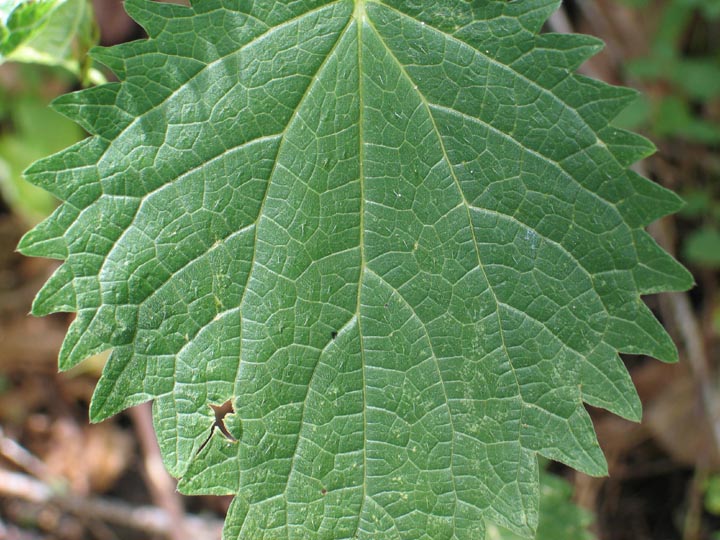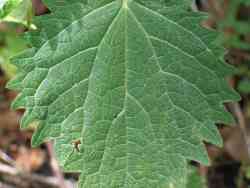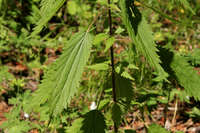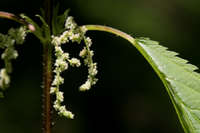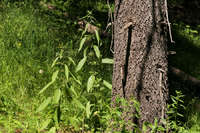Stems glabrous or strigose, with a few stinging hairs. Leaf blades abaxially bearing stinging hairs, otherwise glabrous or puberulent, adaxially without or rarely with a few stinging hairs. Flowers unisexual, staminate and pistillate mostly on same plant. 2 n = 26, 52.
Flowering late spring-summer. Alluvial woods, margins of deciduous woodlands, fencerows, waste places; 0-3100 m; St. Pierre and Miquelon; Alta., B.C., Man., N.B., Nfld., N.W.T., N.S., Ont., P.E.I., Que., Sask., Yukon; Ala., Alaska, Ariz., Calif., Colo., Conn., Del., Ga., Idaho, Ill., Ind., Iowa, Kans., Ky., La., Maine, Md., Mass., Mich., Minn., Miss., Mo., Mont., Nebr., N.H., N.J., N.Mex., N.Y., N.C., N.Dak., Ohio, Okla., Oreg., Pa., R.I., S.Dak., Tenn., Tex., Utah, Vt., Va., Wash., W.Va., Wis., Wyo.
Native Americans used Urtica dioica subsp. gracilis medicinally for rheumatism, upset stomach,childbirth, paralysis, fevers, colds, tuberculosis, and as a general tonic, and as a witchcraft medicine (D. E. Moerman 1986).
LEAVES: Lower surface of leaves glabrous to puberulous, with stinging hairs.
NOTES: See also parent taxon. 2n = 26, 52. Alluvial woods, margins of deciduous woodlands, fencerows, waste places: Apache, Cochise, Coconino, Graham, Navajo cos.; to 3000 m (10,000 ft); late spring summer; across Canada and the n U.S. from AK to the Atlantic, s in the mts. and along the coasts in the U.S., n Mex.
REFERENCES: Boufford, David E. 1992. Urticaceae. Ariz.-Nev. Acad. Sci. 26(1)2.
Perennial herb 0.5 - 3 m tall
Stem: erect to sprawling, unbranched or branched, hairless or with appressed hairs (few stinging).
Leaves: opposite, 6 - 20 cm long, 2 - 13 cm wide, egg-shaped to lance-oblong with a rounded (rarely heart-shaped) base and pointed tip, toothed, usually hairless above, having stinging hairs and sometimes tiny non-stinging hairs beneath.
Flowers: either male or female, usually found on the same plant, borne on axillary branched inflorescences, subtended by narrow triangular to lance-shaped bracts without hooked hairs. The male flowers are ascending and have four tepals and four stamens. Female flowers relaxed to recurved with four tepals, the hairless outer tepals linear to narrow spoon- to lance-shaped and 0.8 - 1.2 mm long, the inner tepals egg-shaped and 1.4 - 1.8 mm long.
Fruit: an egg-shaped achene, 1 - 1.3 mm long, 0.7 - 0.9 mm wide.
Similar species: The typical variety of Urtica dioica has stiff, stinging hairs and flexible, non-stinging hairs on both leaf surfaces.
Flowering: late June to late September
Habitat and ecology: Frequent in rich sediments deposited along streams, waste areas with high nitrates in the soil, bog margins, or near sewage systems and dumps.
Occurence in the Chicago region: native
Etymology: Urtica is the old Latin name for stinging nettle and is derived from the word uro, meaning "to burn." Dioica means dioecious, referring to the male and female flowers growing on separate plants (although they commonly grow on the same plant). Gracilis means slender and graceful.
Author: The Morton Arboretum
Infrequent to frequent in the lake area, becoming infrequent to very rare south of this area and restricted mostly to low places in the alluvial bottoms of our principal streams. It grows in rich, porous soil only in low ground and is found about lakes and ponds in low woods, in low places along unimproved roads in the lake area, in springy places throughout, and in wet places along streams. This species is often confused with Urtica dioica L. which is a native of Europe and has been reported as sparingly escaped in the eastern part of the United States. It has been reported from Indiana but I am referring all of our reports except the one from St. Joseph County to this species. The two species are difficult to separate. The leaves are variable in texture, in shape of the blade and its base, in the number of setose hairs on either surface, in the number of setose hairs on the stem, petioles, and in the inflorescence, and in the size of the panicles. I have 28 specimens from Indiana and 20 of these are monoecious and 8 are pistillate. My specimens represent only the part of the plant with leaves when collected and it is probable that the lower leaves and staminate inflorescences of the pistillate specimens had fallen before the plants were collected. The density of the stand of the plants has a marked influence upon them.


